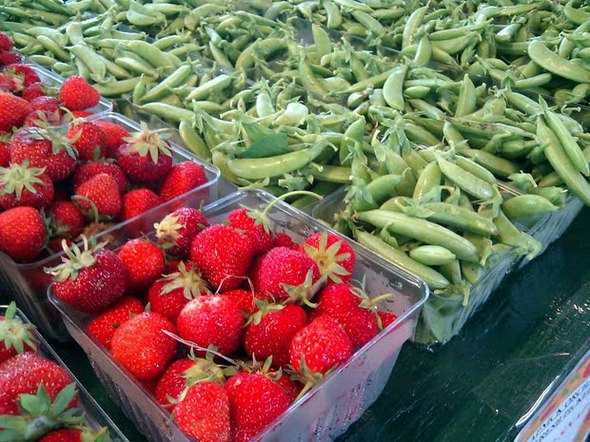Monday links: the strawberry science of jam and sorbet

Kapnick Orchards brought peas and strawberries to Saturday's Ann Arbor Farmers Market. Strawberry prices were $3.75 to $4 for a quart, with $5 quarts of organic berries.
Courtesy Real Time Farms
The theme today is food science, as illustrated by strawberries. Pectin, made from complex polysaccharides, is key to jam. Ice crystals of the right size are the key to sorbet. In both cases, it's worth noting that this year's strawberry crop is relatively watery because of all the rain we've been having, and that affects your recipes for both jam and sorbet.
How to make strawberry jam
Cynthia, who writes the blog Mother's Kitchen, was at the Ann Arbor Farmers Market on Saturday morning along with Ellen Bunting from Growing Hope making strawberry jam. Her strawberry jam recipe skips the boxed pectin and instead uses a fruit pectin made from apples and lemons.
From the event writeup: "We had a whole bunch of berries from Gibbs Berry Farm which I just discovered is in a town called Onondaga, Michigan, south of Lansing. This year, we had so much rain I guessed it would take a long time to get this strawberry jam to set up, and I was right. Normally, boiling the jam that I make with pectin rendered from apples and lemons takes about 20 minutes to get to the right jell temperature, but yesterday, it took much longer....at least 30 minutes."
Kitchen chemistry involving pectin is something I've never understood, so I'm not going to try to describe how it works. I did find an MIT Kitchen Chemistry course, SP.287, complete with a link to Hinton's 1940 paper "The quantitative basis of pectin jelly formation in relation to pH conditions" and other references on the science of making jam. The keys appear to be the relationship between acidity, sugar, pectin and water. I'll have to find an excuse to practice.
More pectin links:
- On the Jelling of Jelly, Sue Ann Bowling, Geophysical Institute, University of Alaska Fairbanks.
- Making Jelly with Added Pectin, Michigan State University
- Honey Lemon Apple Jam recipe from the blog Food in Jars notes that underripe apples have more pectin than fully ripe or old apples.
How to make strawberry sorbet
Without getting into too much of a recipe, here's the strategy you are after when making a strawberry sorbet. Sorbet is much easier than jam, because you're just trying to get the ice crystals in your finished product to be nice and small and smooth so it tastes great.
One piece of the recipe is the sweetener, a simple syrup that's generally just sugar and water. This year's strawberries were very juicy from all of the rain, so the goal was to get as much sugar dissolved in as little water as possible. To do that, use boiling water to dissolve the sugar, and then cool the syrup down with ice cubes back to temperature. If you aren't in a huge hurry, you can also just sprinkle the sugar over the berries and store them in the fridge until they have softened. The sugar will inhibit the growth of mold.
Wash and hull the strawberries. There are specialized tools for strawberry hulling which look like two little spoons on a hinge that you pinch together, or you can use a single spoon as a scoop or even a straight, sharp knife. Make sure you scoop out all the bad spots. Having a helper for picking over the berries can make the task go fast.
Most recipes include something sour, like lemon juice, to cut the sweet taste. Many also include a small amount of liqueur for flavor. There's no reason that you couldn't use a spice that went with the berry flavor, though you'd probably want to heat it in with the syrup to get the flavor out. The alcohol in the liqueur will reduce the freezing point of the sorbet. If you happen to have any sorbet left for some reason (which I don't understand why you would) you can store it and it won't get all icy. The actual proportions will vary depending on how watery the strawberries are, your sweet tooth and how ripe the strawberries are.
Put the fruit and sugar into a blender or food processor and turn the whole thing into a puree, then freeze in your ice cream maker. If you don't have an ice cream maker, you can stir by hand periodically while it's freezing in a large shallow pan. If stirring by hand sounds like too much work, you can take out the pan and send it through the blender or food processor most of the way through.
More strawberry sorbet links:
- Yumsugar's strawberry sorbet is three parts strawberries to one part sugar, by weight.
- Dog Hill Kitchen's Michigan berry sorbets are a cup of sugar to a quart of berries.
- Teresa Shaw contributed Easy Summertime Fruit Sorbet last year, using frozen fruit.
- King Arthur Flour's sorbet recipes look great.
- Beer is an ingredient. An account from Toronto describes the recipe at Beer Bistro for their Fruli Strawberry Beer Sorbet.
Edward Vielmetti eats strawberries for AnnArbor.com. Contact him at edwardvielmetti@annarbor.com.Â


Comments
Jeff Renner
Mon, Jun 14, 2010 : 11:16 a.m.
Perhaps slightly OT since this isn't actually sorbet but rather frozen fruit yogurt, but this is a favorite quick, healthful dessert at our house. 1) Put frozen fruit, single variety or mixed, into a food processor. 2) Process until chopped fine but not pureed. It will become pureed in step #3. 3) While the processor is running, add enough low-fat or non-fat yogurt to produce the consistency of ice cream. Don't over-process or it will melt. This always seems sweet enough for us without added sugar.